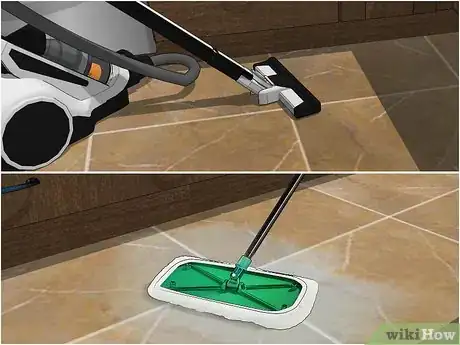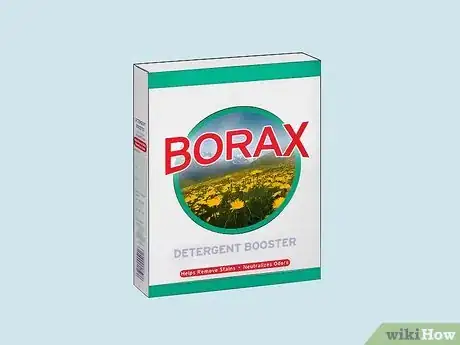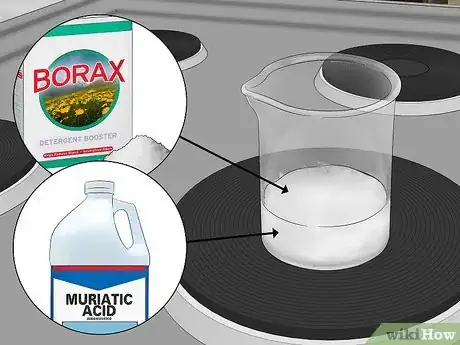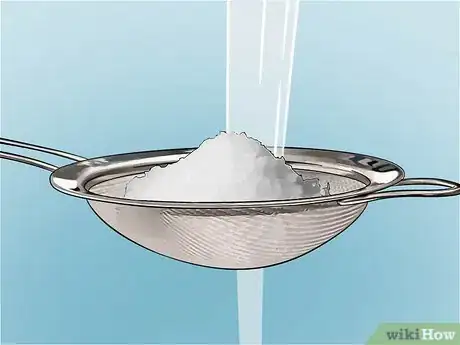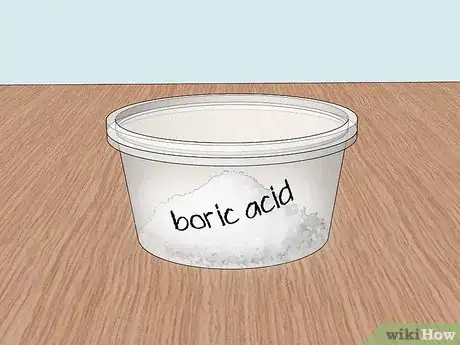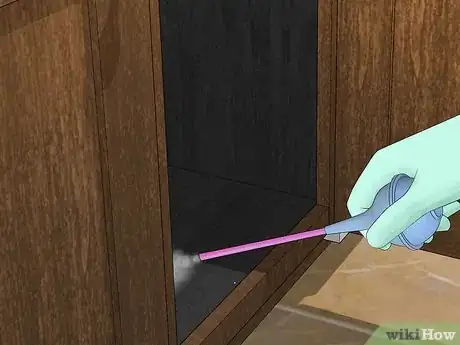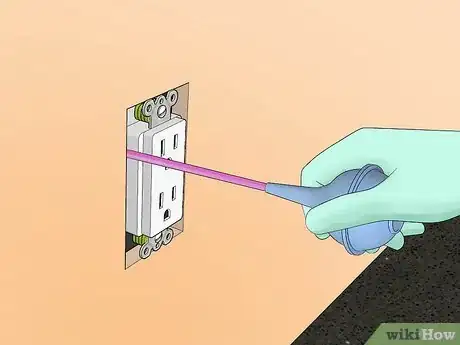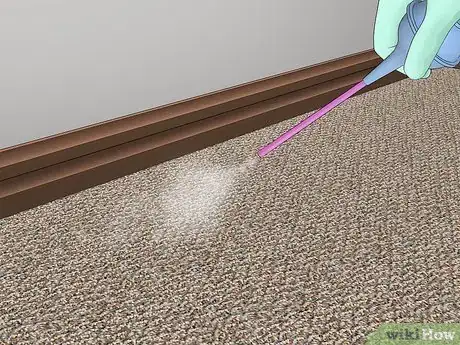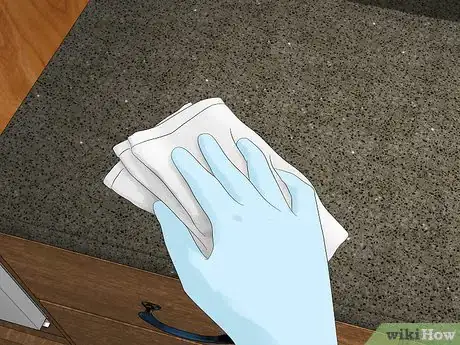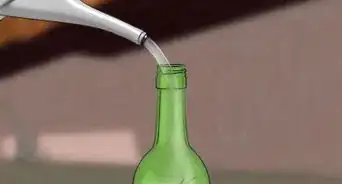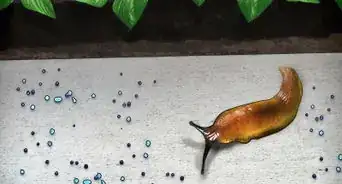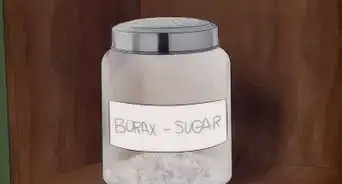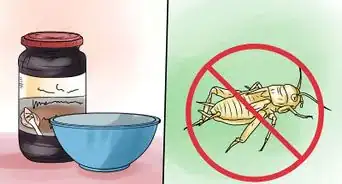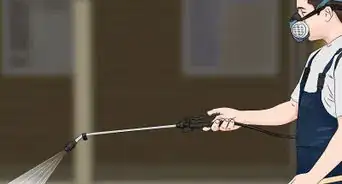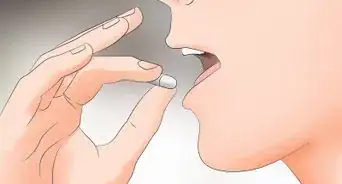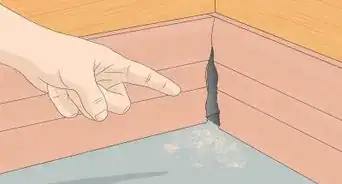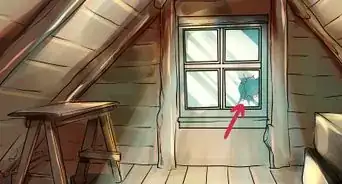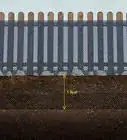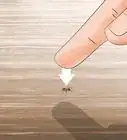This article was co-authored by Kevin Carrillo. Kevin Carrillo is a Pest Control Specialist and the Senior Project Manager for MMPC, a pest control service and certified Minority-owned Business Enterprise (MBE) based in the New York City area. MMPC is certified by the industry’s leading codes and practices, including the National Pest Management Association (NPMA), QualityPro, GreenPro, and The New York Pest Management Association (NYPMA). MMPC's work has been featured in CNN, NPR, and ABC News.
wikiHow marks an article as reader-approved once it receives enough positive feedback. This article received 15 testimonials and 80% of readers who voted found it helpful, earning it our reader-approved status.
This article has been viewed 875,291 times.
If you’re tired of surprise roaches scurrying across your floors and up your walls, borax can be a lifesaver. This natural powdery substance, also called sodium tetraborate, can kill insects like roaches, and it’s easy to use. Check out the steps below to learn how to prepare borax and use it to defend your home against a roach infestation.
Steps
Determining Target Areas
-
1Inventory potential roach habitats in your home. Roaches are omnivorous and seek dark, moist places [1] . Inspect areas around the baseboards of your floor, under or around pipes, anywhere there is food waste, behind electrical outlet covers, and narrow, hard to reach spaces are ripe for potential infestation.[2] Roaches prefer to leave their eggs protected in dark crevices if they are not viviparous or oviparous.
-
2Check these areas for infestation. You can do this by blowing a portable fan around the area to provoke an escape response, or by using an intense sudden light source to provoke the escape response [3] . Leaving bait out without any pesticide is not recommended, as it will simply encourage infestation.Advertisement
-
3Note any areas roaches would live, feed, or lay eggs. These are areas with regular food contact, exposure to water, or that are dark and inaccessible. These areas should be targeted regardless of observed infestation. Boric acid has a strong prophylactic effect that kills generations of insects over time.
-
4Check areas roaches may live for unpleasant smells. Cockroaches have a number of scent glands used in communication and courtship that produce a distinctive smell, in some cases sweet, in others oily and musky. These are telltale signs of an area that is infested and should be targeted.
- Some cockroaches are perching insects that can thrive on top of high surfaces like shelves, and these should be inventoried and cleared for application of the insecticide.
-
5Clean areas of any food debris or standing water.[4] Make sure this is done before preparing or applying the insecticide. Clean surfaces and preventing standing water from building up deprive cockroaches of resources. Bait is unnecessary with this insecticide, and eggs are less likely to be spread where there is no feeding resource for the female insect.
Preparing the Borax
-
1Use borax if you are uncomfortable making boric acid. Boric acid is a more effective insecticide, more soluble in water, and is equally unlikely to produce any lasting harm in humans. Both can be applied as a powder and have identical methods of killing the insect. [5]
-
2React excess hydrochloric acid (muriatic acid) with Borax to produce boric acid and salt water. Boric acid will appear as large white crystals in suspension. Boric acid can be bought as well, and is less hazardous than hydrochloric acid, which is required to convert borax into the far more effective insecticide, boric acid.
- Hydrochloric acid is sold commonly as muriatic acid as a solution to acidify swimming pools. [6]
- Hydrochloric acid should be handled with extreme caution. Use gloves, eye protection, and respiratory protection (in a well-ventilated area) and can cause significant harm. Have baking soda on hand to neutralize any strong-acid reaction that is unintended. Do not use water to treat strong acid burns.[7]
-
3Filter out the boric acid crystals. Treat any excess solution with baking soda to neutralize the strong acid. Do not pour the solution down the sink until you are sure it is neutralized. Use litmus paper to test the acidity of the excess solution. When the crystals are dry they are ready for storage.
Laying the Insecticide
-
1Take the borax or boric acid and place it in a container. Make sure it is clean, inert, clearly labelled container and free of moisture. Proper storage and labeling is key to maintaining safety and avoiding accidentally ingesting the product, as it is visually quite similar to table salt. Avoiding moisture will prevent unwanted large chunks from forming.
- A recycled ketchup bottle can be used as a kind of bellows to distribute the insecticide powder in the tight space of an electrical outlet with minimal risk. Squeeze the bottle to test and make sure dust comes out (take care to not get any in your eyes, mouth or nose). Make sure the hole of the bottle you’re using is large enough for the borax crystals to go through freely.
- Borax is soluble in hot water, as is boric acid and can be dissolved and put in a spray bottle, and the dried residue of aqueous boric acid is essentially undetectable to the insect and low risk to humans. [8] However, if you are applying it near electrical outlets use it as a powder.
-
2Sprinkle or spray the borax or boric acid on target areas. It is unnecessary to mix it with bait, as it is not repellant to insects normally, and is tracked by the insect and spread as a surface toxin to other insects. [9] Once you have covered the areas take care that no food preparation or dusting occurs to prevent accidental ingestion.
- Spread the borax really thin so it's not as visible, or else the roaches will try to avoid it.[10]
-
3Remove electrical outlet covers, dust inside the walls with borax. This is an easy access to interior spaces in walls where roaches live and lay eggs. Spray the borax into the space using your bottle like a bellows, squeezing repeatedly. Replace the outlet covers when done. Do not use dissolved borax.
-
4Cover any noted areas with a light dusting of insecticide. The insecticide will spread among the colony through contact. Complete coverage is desirable, but if any targeted areas have infestations, the insecticide will spread to other insects and kill them, and will not affect the desirability of food to the insects considerably.
-
5Sprinkle the borax or boric acid, dry, on any carpet or rug. The borax will destroy eggs and larvae in the carpet. Vacuum up the powder some 20 minutes after application. Any eggs or insects killed will go up with them. Follow any rug care instructions.
- If you targeted carpeted areas, vacuum a short time after application. Any eggs will be killed in short order, but the insecticide dust can cause lung irritation or toxicity in pets and small children. It is not advisable to leave it in an area where it will be kicked up as dust continually.
-
6Wipe down any targeted areas with a damp cloth before using the surface. Reapply treatment after use, or after several days if roaches are still a problem. This is a relatively slow insecticide, but an extremely effective one. Continue the treatment in this manner until the roaches are gone.
Expert Q&A
Did you know you can get expert answers for this article?
Unlock expert answers by supporting wikiHow
-
QuestionWhere do roaches like to live in my home?
 Kevin CarrilloKevin Carrillo is a Pest Control Specialist and the Senior Project Manager for MMPC, a pest control service and certified Minority-owned Business Enterprise (MBE) based in the New York City area. MMPC is certified by the industry’s leading codes and practices, including the National Pest Management Association (NPMA), QualityPro, GreenPro, and The New York Pest Management Association (NYPMA). MMPC's work has been featured in CNN, NPR, and ABC News.
Kevin CarrilloKevin Carrillo is a Pest Control Specialist and the Senior Project Manager for MMPC, a pest control service and certified Minority-owned Business Enterprise (MBE) based in the New York City area. MMPC is certified by the industry’s leading codes and practices, including the National Pest Management Association (NPMA), QualityPro, GreenPro, and The New York Pest Management Association (NYPMA). MMPC's work has been featured in CNN, NPR, and ABC News.
MMPC, Pest Control Specialist
Warnings
- Preparing boric acid at home can be dangerous, and any use of hydrochloric (muriatic) acid should be conducted with proper ventilation and protective covering.⧼thumbs_response⧽
- Borax is under evaluation in the EU for potential toxicity to expecting mothers. It has been determined by US authorities to be safe, but it is not advisable to expose pregnant or nursing women or small children to insecticides.⧼thumbs_response⧽
References
- ↑ http://link.springer.com/article/10.1007/BF01058193#page-1
- ↑ Kevin Carrillo. MMPC, Pest Control Specialist. Expert Interview. 22 October 2019.
- ↑ http://link.springer.com/article/10.1007/s00359-002-0383-x#page-1
- ↑ Kevin Carrillo. MMPC, Pest Control Specialist. Expert Interview. 22 October 2019.
- ↑ http://jee.oxfordjournals.org/content/59/6/1374.abstract
- ↑ http://www.cdc.gov/niosh/npg/npgd0332.html
- ↑ http://www.cdc.gov/niosh/npg/npgd0332.html
- ↑ http://jee.oxfordjournals.org/content/59/6/1374.abstract
- ↑ http://jee.oxfordjournals.org/content/59/6/1374.abstract
- ↑ Kevin Carrillo. MMPC, Pest Control Specialist. Expert Interview. 22 October 2019.
About This Article
To get rid of roaches with borax, start by sprinkling borax anywhere you’ve found evidence of the insects, like visible eggs. Alternatively, you can dissolve the borax in hot water, then apply it as a spray to these areas. If you suspect there may by roaches in the walls, remove outlet covers and lightly sprinkle borax into the space around the plugs. Finally, to kill roach eggs and larvae, sprinkle borax onto carpets and allow it to sit for 20 minutes before vacuuming. For tips on preparing your own boric acid as a more potent alternative to borax, read on!





